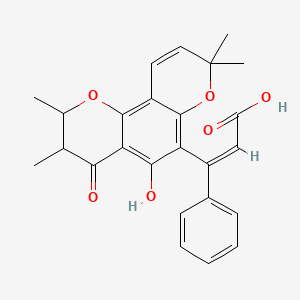
|
Calophyllic acid |
Calophyllic acid is a lipid of Polyketides (PK) class. |
5 |
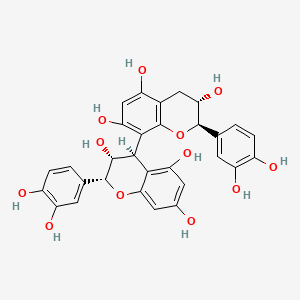
|
Procyanidin B1 |
Procyanidin B1 is a lipid of Polyketides (PK) class. |
47 |
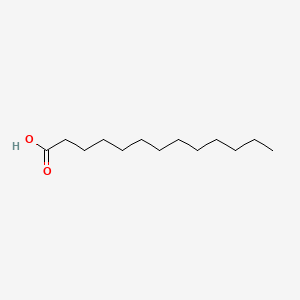
|
TRIDECANOIC ACID |
TRIDECANOIC ACID is a lipid of Fatty Acyls (FA) class. Tridecanoic acid is associated with abnormalities such as Fatty Liver, hypoglycemia and Cardiomyopathies. The involved functions are known as Catalyst, Protein Overexpression, Insulin Resistance, Oxidation and Cell Death. Tridecanoic acid often locates in peroxisome, Mitochondria, Protoplasm, Cytosol and Cell membrane. The related lipids are Tridecanoic Acid, Fatty Acids, Fatty Acids, Nonesterified, stearic acid and margaric acid. |
55 |
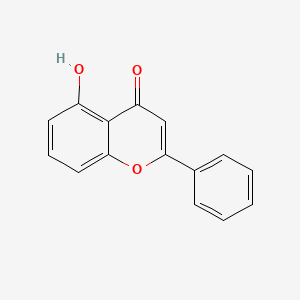
|
5-Hydroxyflavone |
5-Hydroxyflavone is a lipid of Polyketides (PK) class. |
55 |
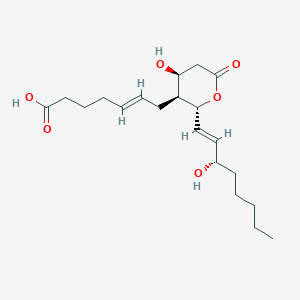
|
11-dehydro-txb2 |
|
98 |
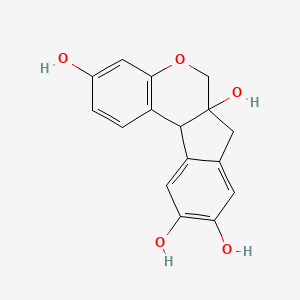
|
Brazilin |
Brazilin is a lipid of Polyketides (PK) class. |
128 |
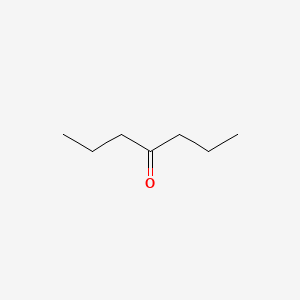
|
4-heptanone |
4-heptanone is a lipid of Fatty Acyls (FA) class. |
145 |
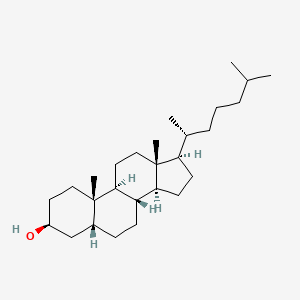
|
Coprosterol |
Coprosterol is a lipid of Sterol Lipids (ST) class. Coprosterol is associated with abnormalities such as Cerebrovascular accident, Glycogen Storage Disease Type IV, Coronary Arteriosclerosis, CARDIAC EVENT and Diabetes Mellitus, Non-Insulin-Dependent. The involved functions are known as cholesterol absorption, Death, Sudden, Cardiac, Drug Interactions, Cholesterol Homeostasis and Synthesis. Coprosterol often locates in lipid raft, Tissue membrane, Membrane, Blood and Body tissue. The associated genes with Coprosterol are ABO gene, STN gene, Alleles, Apolipoprotein E gene and TNF gene. The related lipids are saturated fat, campesterol, lathosterol, Sterols and Total cholesterol. The related experimental models are Rodent Model. |
165 |
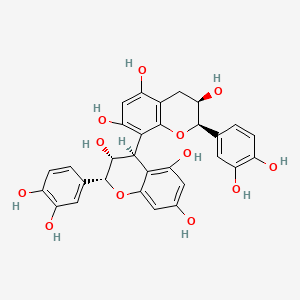
|
Procyanidin B2 |
Procyanidin B2 is a lipid of Polyketides (PK) class. The involved functions are known as conjugation, Methylation, Excretory function, enzyme activity and sulfatase activity. Procyanidin b2 often locates in Blood, Epidermis and Upper Gastrointestinal Tract. The associated genes with Procyanidin B2 are NR5A2 gene, HRAS wt Allele, CFB gene, PTGS2 gene and MAPK8 gene. |
205 |
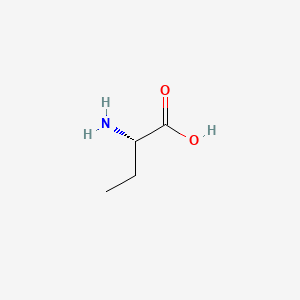
|
L-2-aminobutyric acid |
L-2-aminobutyric acid is a lipid of Fatty Acyls (FA) class. The involved functions are known as Analyte, Noise and drug catabolism. The associated genes with L-2-aminobutyric acid are butyrine. |
281 |
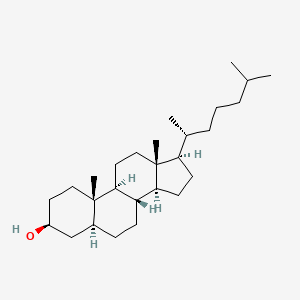
|
Dihydrocholesterol |
Dihydrocholesterol is a lipid of Sterol Lipids (ST) class. Dihydrocholesterol is associated with abnormalities such as Exanthema, Morphologically altered structure, protrusion, Dehydration and Xanthoma. The involved functions are known as Regulation, Biochemical Pathway, Methylation, Metabolic Inhibition and Biosynthetic Pathways. Dihydrocholesterol often locates in envelope, Mitochondria, Lipid Bilayers, Host Cell and Membrane. The associated genes with Dihydrocholesterol are GRAP2 gene, PTP4A2 gene, HSD3B7 gene, MBD2 gene and IGF2BP3 gene. The related lipids are Sterols, Cardiolipins, Pregnanes, 7-hydroxy-4-cholesten-3-one and Hydroxycholesterols. The related experimental models are Mouse Model. |
281 |

|
Tangeretin |
Tangeretin is a lipid of Polyketides (PK) class. Tangeretin is associated with abnormalities such as Cardiovascular Diseases, Complex Regional Pain Syndromes, Blood Clot, Hypercholesterolemia and Restenosis. The involved functions are known as Thrombus, Platelet function, Localized desquamation, Platelet Activation and Signal. Tangeretin often locates in Protoplasm, Cytoplasmic Granules, Cytoplasmic matrix, Plasma membrane and Blood. The associated genes with Tangeretin are GP6 gene, CDK2 gene, CDK6 gene, Tumor Suppressor Genes and CDH1 gene. The related lipids are Lipopolysaccharides. The related experimental models are Mouse Model and Transgenic Model. |
325 |
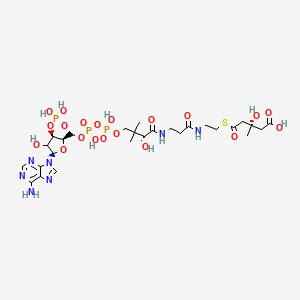
|
HMG-CoA |
Hmg-coa is a lipid of Fatty Acyls (FA) class. Hmg-coa is associated with abnormalities such as Cardiovascular Diseases, Hypercholesterolemia, Metabolic Diseases, Hyperhomocysteinemia and Morphologically altered structure. The involved functions are known as ketone body biosynthetic process, Regulation, Mutation, enzyme activity and HMG-CoA synthase activity. Hmg-coa often locates in Mitochondria, Cytoplasmic matrix, Hepatic, Membrane and Flank (surface region). The associated genes with HMG-CoA are Human gene, HMGCS2 gene, PPARA gene, ACSL1 Gene and Candidate Disease Gene. The related lipids are Fatty Acids, Sterols, Dehydrocholesterols, Lipopolysaccharides and 7-dehydrocholesterol. |
355 |
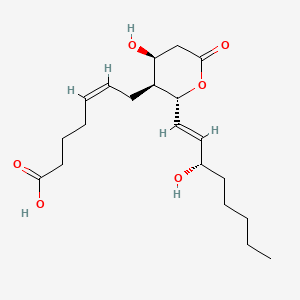
|
11-dehydro-TXB2 |
11-dehydro-txb2 is a lipid of Fatty Acyls (FA) class. 11-dehydro-txb2 is associated with abnormalities such as endothelial dysfunction, Risk factor, cardiovascular, Acute coronary syndrome, thrombocytosis and Chronic ischemic heart disease NOS. The involved functions are known as Platelet Activation, Excretory function, Anabolism, Inflammation and Lipid Peroxidation. The associated genes with 11-dehydro-TXB2 are PTGS2 gene. |
381 |
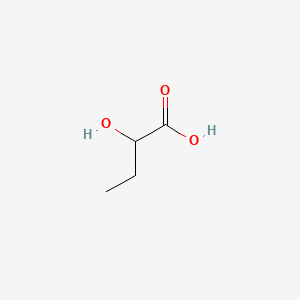
|
(+/-)alpha-hydoxy butyric acid |
(+/-)alpha-hydoxy butyric acid is a lipid of Fatty Acyls (FA) class. |
390 |
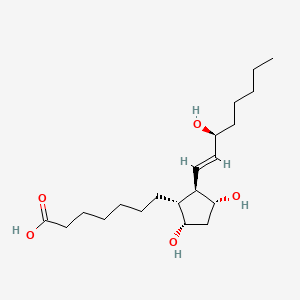
|
PGF1alpha |
Pgf1alpha is a lipid of Fatty Acyls (FA) class. |
418 |
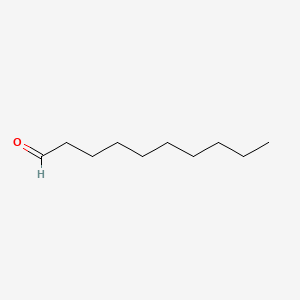
|
Capraldehyde |
Capraldehyde is a lipid of Fatty Acyls (FA) class. |
422 |
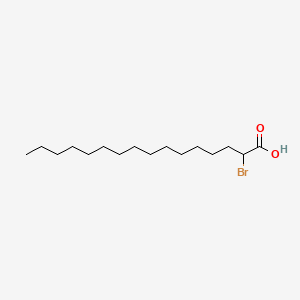
|
2-bromohexadecanoic acid |
2-bromohexadecanoic acid is a lipid of Fatty Acyls (FA) class. 2-bromohexadecanoic acid is associated with abnormalities such as Varicosity and Coronavirus Infections. The involved functions are known as Cell Proliferation, Apoptosis, Binding (Molecular Function), Regulation and Biochemical Pathway. 2-bromohexadecanoic acid often locates in Membrane, Cytoplasm, Mitochondria, Cell surface and Extracellular. The associated genes with 2-bromohexadecanoic acid are SLC33A1 gene, GRK6 gene, RBP1 gene, DST gene and FATE1 gene. The related lipids are Palmitates, Fatty Acids, Nonesterified Fatty Acids, Fatty Acids, Unsaturated and Oleates. |
425 |
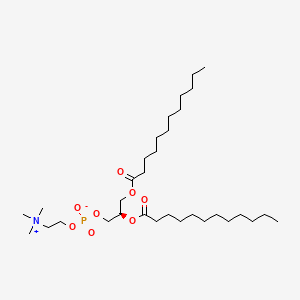
|
18194-25-7 |
18194-25-7 is a lipid of Glycerophospholipids (GP) class. 18194-25-7 is associated with abnormalities such as gaucher's and Disorder, fluids. The involved functions are known as Force, Stereochemistry, Pressure- physical agent, van der Waals Attraction and Complication. 18194-25-7 often locates in Membrane, Tissue membrane, Head, Plasma membrane and Lipid Bilayers. The associated genes with 18194-25-7 are BHLHE41 gene. The related lipids are Liposomes, dilauroyl lecithin, lipid structure, 1,2-oleoylphosphatidylcholine and Unilamellar Vesicles. |
445 |
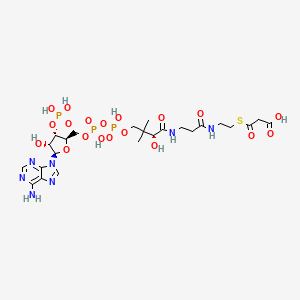
|
Malonyl-coa |
|
492 |
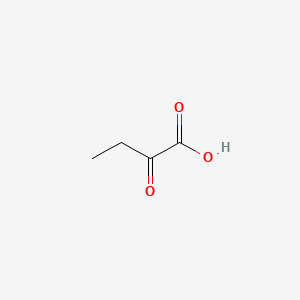
|
3-methyl pyruvic acid |
3-methyl pyruvic acid is a lipid of Fatty Acyls (FA) class. |
623 |
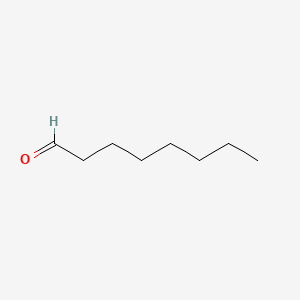
|
Caprylaldehyde |
Caprylaldehyde is a lipid of Fatty Acyls (FA) class. |
677 |
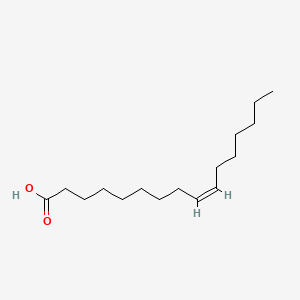
|
cis-9-palmitoleic acid |
Cis-9-palmitoleic acid is a lipid of Fatty Acyls (FA) class. |
694 |

|
PE(15:0/20:0) |
PE(15:0/20:0) is a lipid of Glycerophospholipids (GP) class. Pe(15:0/20:0) is associated with abnormalities such as Exanthema, Infection, Painful Bladder Syndrome, Obesity and Fatty Liver. The involved functions are known as conjugation, Transcription, Genetic, Sinking, Autophagy and Protein Biosynthesis. Pe(15:0/20:0) often locates in membrane fraction, soluble, Membrane, Body tissue and Tissue membrane. The associated genes with PE(15:0/20:0) are GABARAPL2 gene, ATG10 gene, ATG12 gene, SLC33A1 gene and GABARAP gene. The related lipids are Liposomes, Lipopolysaccharides, Phosphatidylserines, Membrane Lipids and Cardiolipins. The related experimental models are Knock-out and Cancer Model. |
723 |
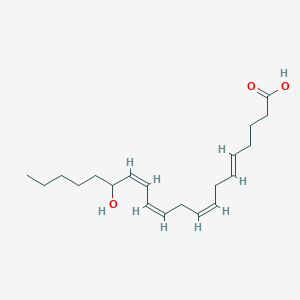
|
15-hete |
15-hete is a lipid of Fatty Acyls (FA) class. The involved functions are known as Inflammation, Signal Transduction, inhibitors, Obstruction and Adjudication. 15-hete often locates in Endothelium, Protoplasm, Cytoplasm, Cytoplasmic and Extracellular. |
725 |
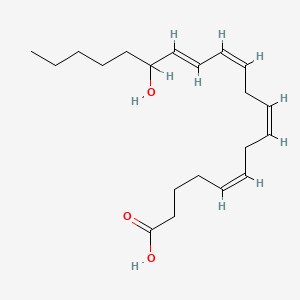
|
15-hete |
15-hete is a lipid of Fatty Acyls (FA) class. 15-hete is associated with abnormalities such as Endothelial dysfunction, Atherosclerosis, Risk factor, cardiovascular, hypercholesterolemia and Diabetes. The involved functions are known as uptake, Inflammation, Phosphorylation, Oxidation and Atherogenesis. 15-hete often locates in Endothelium, Cell surface, Protoplasm, Body tissue and Blood. The associated genes with 15-hete are CD36 gene, CCL2 gene, Orthologous Gene, SMAD2 gene and SMAD3 gene. The related lipids are 9-hydroxy-10,12-octadecadienoic acid and hydroxy fatty acid. |
725 |
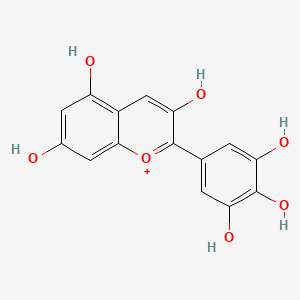
|
Delphinidin |
Delphinidin is a lipid of Polyketides (PK) class. Delphinidin is associated with abnormalities such as Virus Diseases, Chronic disease, Inflammatory disorder, Degenerative polyarthritis and Cardiovascular Diseases. The involved functions are known as Signal Pathways, Metabolic Inhibition, Signal Transduction, Cell Proliferation and Cell Death. Delphinidin often locates in Tissue membrane, Tubulo-reticular structure, Smooth muscle (tissue), Endothelium and soluble. The associated genes with Delphinidin are KDR gene, P4HTM gene, IRAK1 gene, MAPK14 wt Allele and ADAMTS3 gene. The related lipids are Steroids, Total cholesterol and saikosaponin B2. The related experimental models are Xenograft Model, Knock-out, Disease model and Animal Disease Models. |
727 |
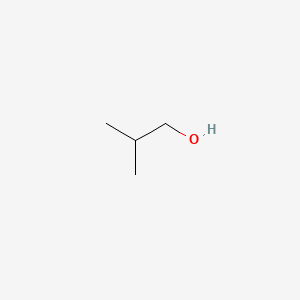
|
2-methyl-1-propanol |
2-methyl-1-propanol is a lipid of Fatty Acyls (FA) class. 2-methyl-1-propanol is associated with abnormalities such as FRIEDREICH ATAXIA 1, Amelia, Tuberculosis, purging and Tuberculosis, Pulmonary. The involved functions are known as Regulation, Oxidation-Reduction, Fermentation, Biochemical Pathway and Glycolysis. 2-methyl-1-propanol often locates in Protoplasm, Chromosomes, Human, Pair 7, BL21, Chromosomes and Cell metabolite. The associated genes with 2-methyl-1-propanol are ADH1B gene, LDHA gene, Operon, AAAS gene and SLC7A3 gene. The related lipids are Butanols, Fatty Alcohols, 1-Butanol, Fatty Acids and cyclopropane fatty acids. The related experimental models are Knock-out. |
758 |
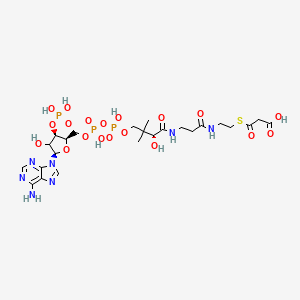
|
Lmfa07050031 |
Lmfa07050031 is a lipid of Fatty Acyls (FA) class. The involved functions are known as Pigment and Polymerization. The related lipids are Propionate. |
787 |
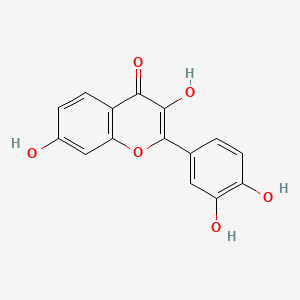
|
Fisetin |
Fisetin is a lipid of Polyketides (PK) class. Fisetin is associated with abnormalities such as Morphologically altered structure, PARKINSON DISEASE, LATE-ONSET, Tetanus, CNS disorder and Disintegration (morphologic abnormality). The involved functions are known as Autophagy, Apoptosis, Energy Metabolism, Acceleration and Anabolism. Fisetin often locates in Mitochondria, Cytoplasmic matrix, Extracellular, Cytoskeletal Filaments and Autophagic vacuole. The associated genes with Fisetin are SIRT1 gene, MAP1LC3A gene, TP53 gene, P4HTM gene and AURKB gene. The related lipids are Phosphatidylserines and Lipopolysaccharides. The related experimental models are Animal Cancer Model, Xenograft Model, Mouse Model, Cancer Model and Disease model. |
832 |
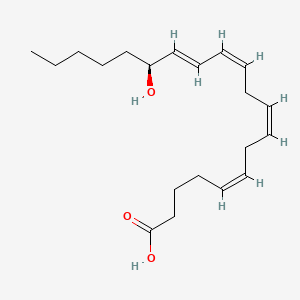
|
15S-HETE |
15s-hete is a lipid of Fatty Acyls (FA) class. 15s-hete is associated with abnormalities such as Ischemia and Vascular Diseases. The involved functions are known as Transcription, Genetic, Signal Transduction, tube formation, Angiogenic Process and Biochemical Pathway. 15s-hete often locates in Endothelium, Membrane, Cytoplasm, Body tissue and Protoplasm. The associated genes with 15S-HETE are RAC1 gene, ALOX15 gene, ALOX5 gene, Candidate Disease Gene and GAPDH gene. |
1011 |
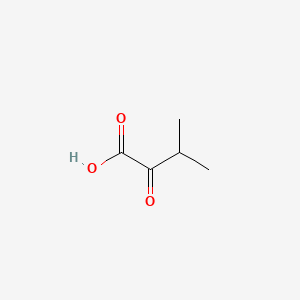
|
3-Methyl-2-oxobutanoic acid |
3-Methyl-2-oxobutanoic acid is a lipid of Fatty Acyls (FA) class. 3-methyl-2-oxobutanoic acid is associated with abnormalities such as Maple Syrup Urine Disease and Kidney Failure, Chronic. The involved functions are known as Phosphorylation, Citric Acid Cycle, inhibitors, Process and Metabolic Control. 3-methyl-2-oxobutanoic acid often locates in Mitochondria, BL21, Cytoplasm, Ribosomes and Head. The associated genes with 3-Methyl-2-oxobutanoic acid are Genome, Homologous Gene, Operon, Alleles and Oxidoreductase Gene. The related lipids are dimyristoylphosphatidylglycerol, 9-oxononanoic acid, Valerates and alpha-ketocaproic acid. |
1021 |
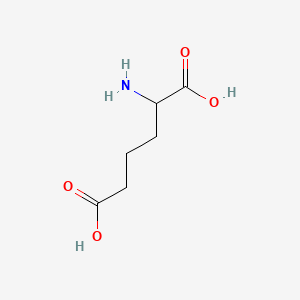
|
Aminoadipic acid |
Aminoadipic acid is a lipid of Fatty Acyls (FA) class. Aminoadipic acid is associated with abnormalities such as Diabetes and Proliferative retinopathy NOS. The involved functions are known as Uptake, Process, lysine catabolism, Pressure- physical agent and Proteolysis. Aminoadipic acid often locates in Protoplasm, Chromosomes, Astrocytic, Basal lamina and Cytoplasmic matrix. The associated genes with Aminoadipic acid are Homologous Gene, Excitatory Amino Acids, allysine, Diaminopimelic Acid and Gene Clusters. |
1114 |
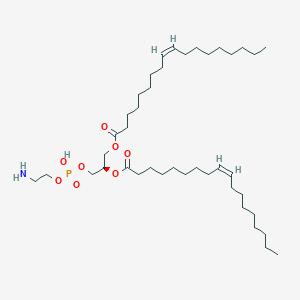
|
PE(18:1(9Z)/18:1(9Z)) |
PE(18:1(9Z)/18:1(9Z)) is a lipid of Glycerophospholipids (GP) class. Pe(18:1(9z)/18:1(9z)) is associated with abnormalities such as Respiratory Failure, Myopathy, Muscular Dystrophy, Duchenne, Autoimmune Lymphoproliferative Syndrome and Osteoporosis. The involved functions are known as establishment and maintenance of localization, Anabolism, Protein Biosynthesis, nuclear mRNA cis splicing, via spliceosome and Increased Sensitivy. Pe(18:1(9z)/18:1(9z)) often locates in Sarcolemma, Muscle, Membrane, viral nucleocapsid location and Tissue fiber. The associated genes with PE(18:1(9Z)/18:1(9Z)) are DMD gene, DUOXA1 gene, P4HTM gene, delta sleep-inducing peptide, N-Tyr- and Homologous Gene. The related lipids are Lipofectin, Liposomes, Pregnadienes, N-(1-(2,3-dioleyloxy)propyl)-N,N,N-trimethylammonium chloride and DOPE. |
1117 |
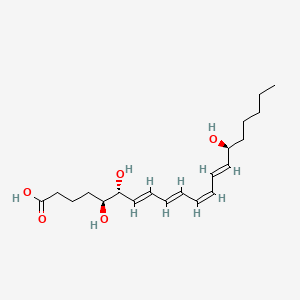
|
Lipoxin A4 |
Lipoxin a4 is a lipid of Fatty Acyls (FA) class. Lipoxin a4 is associated with abnormalities such as Asthma, Cystic Fibrosis, Pneumonia, Obesity and Septicemia. The involved functions are known as Inflammation, Signal, Signal Transduction, Regulation and Metabolic Inhibition. Lipoxin a4 often locates in Immune system, Blood, soluble, Extracellular and Splenic Tissue. The associated genes with Lipoxin A4 are FPR2 gene, Homologous Gene, SAA1 gene, Trp-Lys-Tyr-Met-Val-Met and Annexin 1. The related lipids are Steroids. The related experimental models are Knock-out. |
1240 |
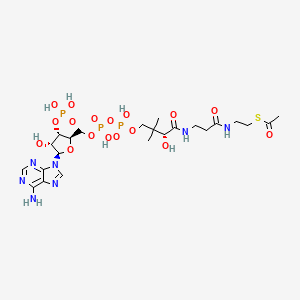
|
Acetyl-coa |
|
1243 |
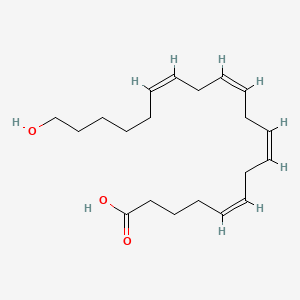
|
20-HETE |
20-hete is a lipid of Fatty Acyls (FA) class. 20-hete is associated with abnormalities such as Cyst, Kidney Diseases, Kidney Failure, Chronic, Cystic Kidney Diseases and Simple renal cyst. The involved functions are known as Phosphorylation, inhibitors, Hypertrophy, Epithelial Cell Proliferation and Anabolism. 20-hete often locates in Mouse Kidney, Microsomes, Tissue membrane, Body tissue and Cytoplasmic matrix. The associated genes with 20-HETE are CYP4F3 gene, PKHD1 gene, Transgenes, P4HTM gene and CYP2E1 gene. The related lipids are Promega, enterodiol, Fatty Acids, hexanoic acid and U 73343. The related experimental models are Mouse Model, Knock-out, Streptozotocin Diabetes, Transgenic Model and Rodent Model. |
1257 |

|
SCHEMBL105486 |
Kakonein is a lipid of Polyketides (PK) class. Kakonein is associated with abnormalities such as Fatty Liver, Chronic liver disease, Morphologically altered structure, Hypertensive disease and Cardiovascular Diseases. The involved functions are known as protein expression, Extravasation, Liver damage, mRNA Expression and cell activation. Kakonein often locates in Body tissue, Hepatic, Microvilli, Cytoplasm and Membrane. The associated genes with Kakonein are TJP1 gene, CD14 gene, iberiotoxin, AT-Rich Interactive Domain-Containing Protein 1A and NKS1 gene. The related lipids are dehydrosoyasaponin I and Steroids. The related experimental models are Knock-out. |
1391 |
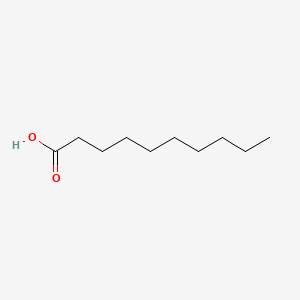
|
Decanoic acid |
Decanoic acid is a lipid of Fatty Acyls (FA) class. Decanoic acid is associated with abnormalities such as Hashimoto Disease, Perisylvian syndrome, Parasitic Diseases, Acute myocardial infarction and Myocardial Infarction. The involved functions are known as Cell Differentiation process, Inflammation, Process, Subtraction process and Pressure- physical agent. Decanoic acid often locates in Epithelium, Tissue membrane, Body tissue, Membrane and Organelles. The associated genes with Decanoic acid are Genome, FATE1 gene, HTR3A wt Allele, FFAR1 gene and O3FAR1 gene. The related lipids are Membrane Lipids, Fatty Acids, Micelles, Stearic acid and rac-glycerol 1-monodecanoate. |
1677 |
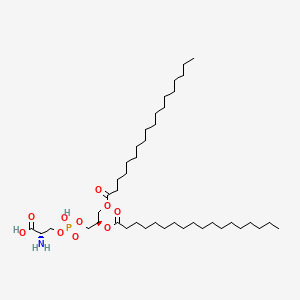
|
51446-62-9 |
51446-62-9 is a lipid of Glycerophospholipids (GP) class. 51446-62-9 is associated with abnormalities such as Virus Diseases, Infection, Bacterial Infections, Communicable Diseases and Exanthema. The involved functions are known as Phagocytosis, Obstruction, Binding (Molecular Function), targeting and inhibitors. 51446-62-9 often locates in Head, Clone, Cell membrane, Cell surface and host. The associated genes with 51446-62-9 are Homologous Gene, Orthologous Gene, Fusion Protein, ETV3 gene and Amino Acids, Basic. The related lipids are Phosphatidylserines, Lipopolysaccharides, 1-palmitoyl-2-oleoylphosphatidylethanolamine, beta-amyrin and Membrane Lipids. |
1744 |
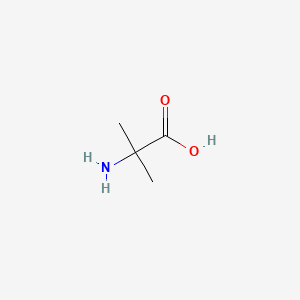
|
2-amino-isobutyric acid |
2-amino-isobutyric acid is a lipid of Fatty Acyls (FA) class. |
1792 |
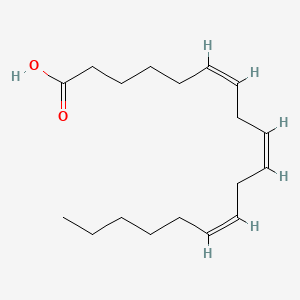
|
gamma-Linolenic acid |
Gamma-linolenic acid is a lipid of Fatty Acyls (FA) class. The involved functions are known as Drug Interactions. Gamma-linolenic acid often locates in Articular system. |
1919 |

|
Sphingosine 1-phosphate |
Sphingosine 1-phosphate is a lipid of Sphingolipids (SP) class. Sphingosine 1-phosphate is associated with abnormalities such as Infection, Painful Bladder Syndrome, Atherosclerosis, Hyperglycemia and Rheumatoid Arthritis. The involved functions are known as Phosphorylation, Regulation, enzyme activity, Energy Absorption and Vascular Permeability. Sphingosine 1-phosphate often locates in Endothelium, Tissue membrane, Vascular System, Protoplasm and Microfilaments. The associated genes with Sphingosine 1-phosphate are MBTPS1 gene, FBXL15 gene, TEK gene, NTRK1 gene and Gene Family. The related lipids are Promega, Lipopolysaccharides, lysophosphatidic acid, Lysophosphatidylcholines and Lysophospholipids. The related experimental models are Knock-out, Mouse Model, Transgenic Model, Disease model and Experimental Autoimmune Encephalomyelitis. |
2005 |

|
FLAVONE |
FLAVONE is a lipid of Polyketides (PK) class. Flavone is associated with abnormalities such as Cardiovascular Diseases, Cerebrovascular accident, DERMATITIS HERPETIFORMIS, FAMILIAL, Hyperinsulinism and Inflammatory disorder. The involved functions are known as Oxidation-Reduction, Metabolic Inhibition, Inflammation, Phosphorylation and antioxidant activity. Flavone often locates in Endothelium, Hepatic, Protoplasm, Body tissue and Extracellular. The associated genes with FLAVONE are ICAM1 gene, BCL2L1 gene, MYC gene, TP53 gene and cytochrome c''. The related lipids are Promega, Steroids and Total cholesterol. The related experimental models are Knock-out, Disease model and Animal Disease Models. |
2093 |
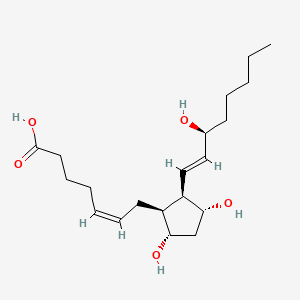
|
15-F2t-IsoP |
15-f2t-isop is a lipid of Fatty Acyls (FA) class. 15-f2t-isop is associated with abnormalities such as Diabetes Mellitus, Acute coronary syndrome, Risk factor, cardiovascular, thrombocytosis and Chronic ischemic heart disease NOS. The involved functions are known as Anabolism, Inflammation, Lipid Peroxidation, Excretory function and Platelet Activation. The associated genes with 15-F2t-IsoP are PTGS2 gene. |
2120 |
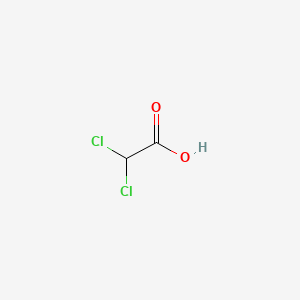
|
Dichloroacetic acid |
Dichloroacetic acid is a lipid of Fatty Acyls (FA) class. Dichloroacetic acid is associated with abnormalities such as Acidosis, Lactic, Metabolic Diseases, CLEFT LIP, CONGENITAL HEALED, Asthma and hyperthyroid. The involved functions are known as inhibitors, Chlorination, Metabolic Inhibition, Process and Sterility. Dichloroacetic acid often locates in Intestine - Large Intestine - Cecum (MMHCC), Mouse Liver, Back and Head. The associated genes with Dichloroacetic acid are GSTZ1 gene, PSMA5 gene and Maleylacetoacetate isomerase. The related lipids are Nonesterified Fatty Acids. |
2361 |
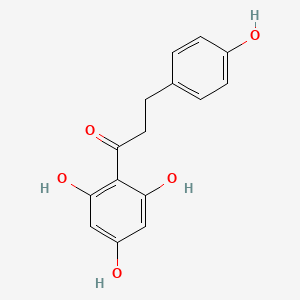
|
phloretin |
phloretin is a lipid of Polyketides (PK) class. Phloretin is associated with abnormalities such as Atherosclerosis, Diabetes Mellitus, Non-Insulin-Dependent, Alkalemia, Renal tubular disorder and pathologic fistula. The involved functions are known as Anabolism, glycosyltransferase activity, Biosynthetic Pathways, Localized desquamation and Biological Processes. Phloretin often locates in soluble, BL21, Cytoplasmic, Extracellular and Cytoplasm. The associated genes with phloretin are Homologous Gene, CD36 gene, Candidate Disease Gene, SLC33A1 gene and PAK1IP1 gene. The related lipids are Liposomes, Palmitates, Fatty Acids, Sterols and 6-ketocholestanol. The related experimental models are Knock-out. |
2367 |
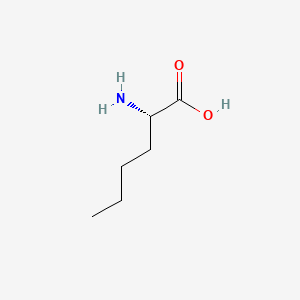
|
L-norleucine |
L-norleucine is a lipid of Fatty Acyls (FA) class. L-norleucine is associated with abnormalities such as Neonatal maladjustment syndrome, Virus Diseases, Kidney Failure, Chronic, Infection and Acquired Immunodeficiency Syndrome. The involved functions are known as Proteolysis, Metabolic Inhibition, Oxidation, immunoreactivity and Sterility. L-norleucine often locates in Blood, Body tissue, Membrane, Protoplasm and Adipose tissue. The associated genes with L-norleucine are N(6)-carboxymethyllysine, P4HTM gene, Polypeptides, EIF3K gene and aminoacid analog. The related lipids are Liposomes and Membrane Lipids. |
2389 |

|
naringenin |
naringenin is a lipid of Polyketides (PK) class. Naringenin is associated with abnormalities such as Dehydration, Papillon-Lefevre Disease, BOSLEY-SALIH-ALORAINY SYNDROME, Cardiovascular Diseases and Atherosclerosis. The involved functions are known as Pigmentation, Biosynthetic Pathways, metaplastic cell transformation, 4-coumarate-CoA ligase activity and Pigment. Naringenin often locates in Body tissue, Cell Wall, Membrane, Cytoplasmic matrix and Tissue membrane. The associated genes with naringenin are Genome, Genes, Regulator, Alleles, Homologous Gene and SPEN gene. The related lipids are Fatty Acids, Total cholesterol, Lipopolysaccharides, Oleates and Cholesterol, Dietary. The related experimental models are Knock-out and Mouse Model. |
2420 |
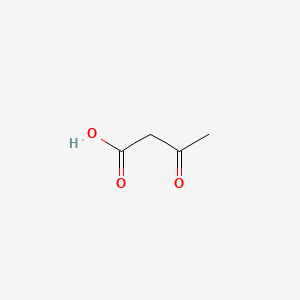
|
Acetoacetic acid |
Acetoacetic acid is a lipid of Fatty Acyls (FA) class.Acetoacetic acid is associated with abnormalities such as Dehydration. The involved functions are known as Biochemical Reaction, intracellular signal transduction, fatty acid elongation, Cytokinesis and Mass-to-Charge Ratio. The associated genes with Acetoacetic acid are CFB gene and mersacidin. Acetoacetic acidis associated with Carbon, Acids, Potassium, Acetoacetic acid and Oximes. The related lipids are Nonesterified Fatty Acids and Stearates. |
2523 |

















































